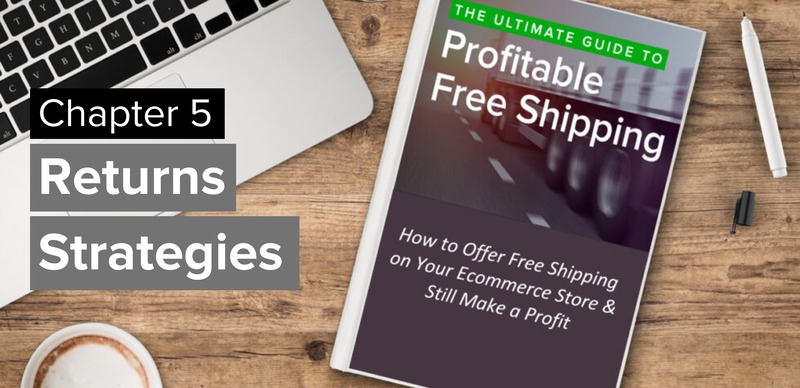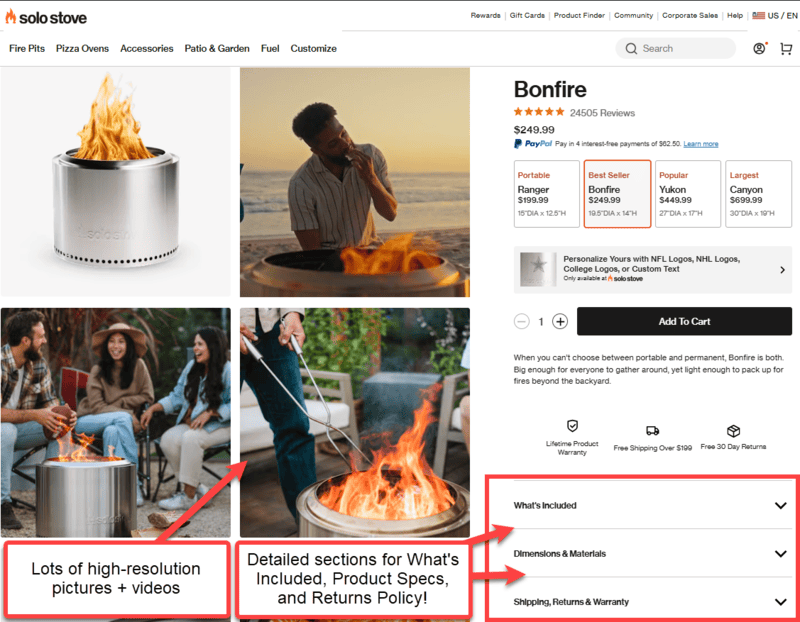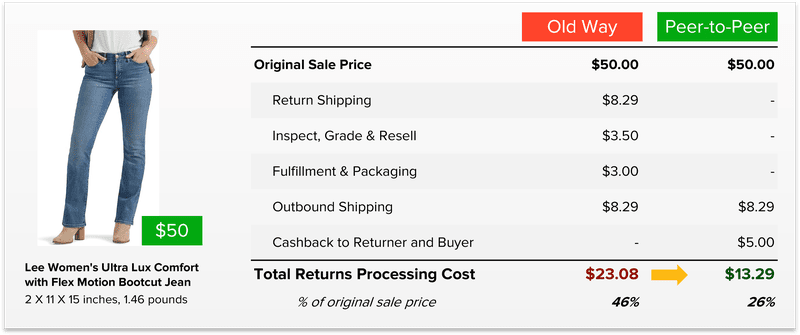Top 7 Returns Optimization Strategies For Making Free Shipping Profitable

Last updated on March 13, 2025

In this article
 15 minutes
15 minutes
- Eliminate the Root Cause(s) for Your Returns
- Offer Local In-Store Returns to Save on Shipping
- Use Consolidator Services for International Returns
- Restrict Returns from High-Risk Profiles or Categories
- Pre-create Return Shipping Labels
- Listen to Your Comprehensive Customer Feedback
- Add a Recommerce Program
- Summary
- Frequently Asked Questions
Offering free shipping to your customers can be a powerful driver of sales and a long-term retention mechanism, but what happens when customers start sending products back? Without an optimized returns strategy, reverse logistics can eat into your margins, making free shipping unsustainable. The good news is that businesses can take control of their returns process, turning it from a costly necessity into a manageable, or even profitable, part of their operation. From improving product descriptions to leveraging recommerce programs, this guide will walk you through seven key strategies to optimize returns and make free shipping a viable, long-term customer acquisition and retention strategy.
1. Eliminate the Root Cause(s) for Your Returns
Prevention is the best medicine. The best-case scenario is for customers to not have a reason to return something at all. There are three major preventable reasons why customers return a product: (1) the product doesn’t match their expectations when buying, (2) they don’t like the product right away but they still might in time, and (3) they bought the product by mistake.
Mismatched Expectations
What customers see on the product page needs to be precise. Product descriptions should be elaborate and always have a detailed specifications section, mainly because different customers value different features. Size charts and physical specifications (such as weight and dimensions), also help shoppers make the right choice the first time.
There is more than one way to populate a good product page, below is an example from Solo Stove:

Visualization is important to convey the real product value. Add multiple photos from all relevant angles, and if possible, a video too. It’s a more realistic depiction of the product in action. With new developments in AR and VR, a few apps also allow customers to try their products virtually. Amazon’s virtual changing room allows you to use your phone camera in the mobile shopping app to try outfits on your virtual avatars. Warby Parker has used similar technology on their website so users can ‘see’ what they would look like in a pair of frames. Nespresso’s augmented reality solution enables users to ‘see’ what a new coffee machine would look like on their kitchen counter, rotating it in virtual space to adjust fit and orientation. Some third-party applications let customers try on products virtually across different online stores.
Having multiple helpful and fair reviews of your product is also essential. This adds to the transparency of your product’s limitations and will prevent customers from surprises. Having numerous honest reviews with photos adds to the credibility of your product. Although only a handful of customers are willing to leave reviews, it’s a worthwhile effort to ask for one.
Tools like Amazon’s Frequently Returned Item Badge may turn off a small percentage of customers and push them in a different direction, but when the cost of reverse logistics for a product is particularly high, preventing the return in the first place may be better than absorbing the painful cost later. Because different customers value different features and functionality, and because sizing charts can only provide so much guidance, knowing the reason for frequent returns may enable them to select the next larger size or a different color. This feature is similar to having high-quality reviews and helps customers spend the time reading through reviews to learn what other’s experiences with your products were.
Not Liking Something Right Away
Some products such as home decor may take some getting used to and you should try increasing the return window for these products. You would think that a larger return window would increase the number of returns, but it can actually have the opposite impact as it removes the pressure to return it as soon as possible. The longer the product stays with the customer, the more it can grow on them, something economists call the endowment effect.
Bought by Mistake
In the event of a mistake during check out, give customers the option to cancel their order within a short period of time after placing the order. This gives them the opportunity to reorder the correct item before fulfillment begins, preventing the inevitable return before it costs you money for all the logistics and reverse logistics. An example of this is accidentally purchasing the Solo Stove Lite which is a small tabletop item that fits in the palm of your hand, not a less heavy fire pit. Having high-quality descriptions, and pictures could prevent this, but giving customers enough time to correct the mistake could help prevent a future return.
It all boils down to having a killer product page. Building it is an interactive process, and it is important to understand why returns happen, so you can take the steps to improve the product page.
Having support available for customers to ask questions would also reduce preventable returns. Some products like furniture require some assembly, and sometimes customers get confused. At that peak frustration point, customers will then return the product. Having a customer service line (even if it’s with the manufacturer and not the Seller), can defuse the situation before returns happen.
2. Offer Local In-Store Returns to Save on Shipping

Now that you’ve finished dealing with the main reasons for product returns, it’s time to look into making returns more efficient and profitable. Offering returns to your retail store (or using an attended kiosk solution such as Happy Returns, Loop Returns, or Narvar) has several significant benefits:
- You (or the customer) won’t pay for return shipping.
- It prevents fraud because a human is accepting the return, even if it only gets a cursory inspection.
- It creates an opportunity to increase sales and makes up for restocking fees.
- Returning at a store or attended kiosk is easier for customers who dislike the hassle of repackaging and shipping the product back to the Seller because by nature, they are boxless and don’t require a printer to print a shipping label.
As long as customers don’t mind going to a store, it’s also faster for smaller issues such as a t-shirt size exchanges.
A UPS survey found that 70% of customers who returned an item at a physical store ended up buying something else during that trip. So even if a customer is not interested in the product anymore, there’s an opportunity to upsell other items in the store. You can also enhance that conversion with coupons offering discounts for customers coming for returns. For example, Kohl’s gives anyone returning Amazon products at its stores a coupon, anywhere from 25% off an item, to $5 flat discount. Staples offers 10% off to customers returning partner retailer items, good for 14 days.
3. Use Consolidator Services for International Returns
If you sell internationally, returns can be a massive logistical headache. Not only is it expensive and complicated with different carriers, but it also includes dealing with border customs. Moreover, if you are selling on marketplaces such as Amazon, you are required to offer local return addresses in countries you’re selling to and free return services.
However, international returns can be very pricy through carriers, forwarders, or FBA. Some solutions exclusively handle international returns such as InterCultural Elements, Salessupply, or ReBOUND. They consolidate product returns similar to domestic return desks at Staples, Kohl’s, The UPS Store, etc. and ship them back to retailers in bulk to cut down return shipping costs. These services collect returned items from multiple Sellers into one warehouse in one country, (e.g., all returns from your customers in Spain), and ship them by pallet-load to their source country’s warehouse, (e.g., InterCultural Element’s warehouse in the UK), then forward the consolidated returned products from all countries back to each Seller’s warehouse (e.g., your main warehouse in the US).
Taking advantage of international returns consolidation services can help save a lot of time and money that can be reinvested into a free shipping program.
4. Restrict Returns from High-Risk Profiles or Categories
Segmentation is a practice adopted by marketers to design different shipping strategies to attract and retain customers who have different personalities, demographics, and interests. The same technique can be used to prevent returns by identifying high-risk customers and offering free return promos to customers who are unlikely to return. Of course, this depends on the Seller’s ability to identify which high-risk profiles are bad actors (e.g. fraudsters and abusers).
The idea is to analyze data from previous returns and identify the commonalities between the customers with the highest number of returns. You can use R to perform a segmentation analysis, or perform regressions analysis to predict factors that contribute to returns, or advanced data science techniques like difference-in-differences. The success of the analyses above depends heavily on your ability to gather and process customer data. As an alternative, the Cahoot network analyzes returned orders across its entire network so it can help identify the customers with high-risk profiles.
Another method is to find which product categories are more prone to returns based on past sales. Some categories are more prone to returns, such as Apparel, Accessories, and Consumer Electronics. You should consider limiting free returns on high return rate items.
5. Pre-create Return Shipping Labels
Businesses have used pre-created and pre-paid shipping in the context of business reply mail for a long time (you may have seen free return envelopes with a “no postage necessary if mailed in the United States” message where the stamp would usually go). But pre-created return shipping labels can be equally applicable for online stores to provide to the customer either physically in advance (including it with the original purchase) or printable from an online portal. The idea is that by using intelligent shipping and returns software, you can pre-determine the cheapest return shipping method and make it available to the customer. For example, by using a slower consolidator (a.k.a. hybrid) carrier and service such as UPS SurePost, FedEx Ground Economy, or DHL, you control your return shipping costs in advance, rather than leaving it to chance (or human judgment) later on. This ensures that you’re getting the best deal on the return shipping as possible, should the order be returned.
Note that while carriers invoice you for these shipping labels only after they’re used, you must not pre-create USPS shipping labels, as they are paid for at the time of creation, regardless of whether they’re used or not.
Precreated shipping labels are a great way to process returns quickly with known tracking numbers and without any address mistakes that could lead to lost returned packages.
6. Listen to Your Comprehensive Customer Feedback
The key here is getting a deeper understanding of why returns happen. We need to make customer feedback a central element of the entire returns process, firstly, by enriching the quality of reasons why the return happened at all. A simple questionnaire makes the returns process easy, but short simple answers don’t really explain the root cause of returns. Instead, an online Seller can ask customers to initiate a return by including a detailed reason in more descriptive terms, either in a returns portal, or by email, chat, or call.
This can have three benefits. Firstly, you will be able to get explicit and detailed reasons for the dissatisfaction. The insights can then be used to improve the selling process or catalog. Secondly, if the reason for return is easily fixable like an assembly error, support can help problem-solve and reverse the dissatisfaction and retain the revenue. Thirdly, customers will only make the effort to call and email to initiate returns if they are absolutely certain about a return. This deters people who are unsure about the product and possibly encourages them to give the product another try before returning.
7. Add a Recommerce Program
Recommerce, or reverse commerce, is giving new life to pre-owned, refurbished, and excess goods. This sustainable approach benefits both consumers and businesses by reducing waste, offering more affordable alternatives, and supporting the circular economy.
The movement appeals to cost-conscious shoppers, eco-conscious consumers, and businesses looking to monetize returned or second-hand products in a structured, profitable way. Several marketplace examples connecting buyers and Sellers include eBay, Facebook Marketplace, ThredUp, and Poshmark.
Some notable brands are extremely vocal about their sustainability programs. Examples include the Allbirds ReRun program, and lululemon’s Like New resale program.
By supporting a recommerce program, you can recapture revenue from these items that would have otherwise gone to a landfill and use it to support your free shipping program.
Summary
A well-managed returns strategy is key to recovering revenue that can be used to fuel a free shipping program without compromising profitability. By reducing unnecessary returns, offering convenient in-store or consolidated return options, and finding innovative ways to recapture value from returned goods, businesses can control costs and even turn returns into a competitive advantage. The best approach is one that continually adapts – leveraging data, refining policies, and investing in smarter logistics. In the end, businesses that master returns optimization won’t just survive the challenges of offering free shipping, they’ll thrive because of it.
Download The Ultimate Guide to Profitable Free Shipping
Frequently Asked Questions
Does offering free returns increase sales?
It inspires customer loyalty. Over 60% of shoppers say that paying to return a product isn’t fair, while 72% say they’d only buy from sites offering free returns. As the eCommerce marketplace is more competitive than ever, it’s vital to nurture customers and ensure they stay loyal to your business.
Should I offer free returns?
Free returns increase brand loyalty. In a survey by Klarna, 86% of online shoppers agreed that they are more likely to return to online merchants who offer free returns and 75% said that they will buy more over time if free returns are offered.
Why are returns so expensive?
The higher the return volume, the more warehouse space you will need, and this costs a lot of money. In addition to the warehouse space itself, you also need to pay warehouse workers to accept the incoming daily returns, which sometimes arrive in many individual parcels.
Do online stores lose money on returns?
Yes, online stores lose money on returns. Returns can cost online retailers money in a number of ways, including lost revenue, labor costs, double-shipping costs, and environmental impact.

Up to 64% Lower Returns Processing Cost


